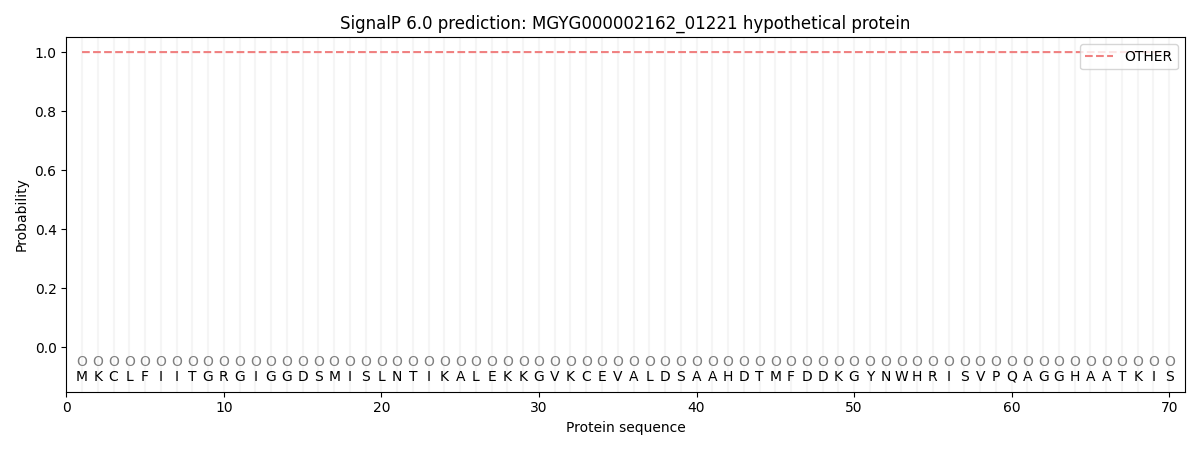You are browsing environment: HUMAN GUT
CAZyme Information: MGYG000002162_01221
You are here: Home > Sequence: MGYG000002162_01221
Basic Information |
Genomic context |
Full Sequence |
Enzyme annotations |
CAZy signature domains |
CDD domains |
CAZyme hits |
PDB hits |
Swiss-Prot hits |
SignalP and Lipop annotations |
TMHMM annotations
Basic Information help
| Species | Methanobrevibacter_A oralis | |||||||||||
|---|---|---|---|---|---|---|---|---|---|---|---|---|
| Lineage | Archaea; Methanobacteriota; Methanobacteria; Methanobacteriales; Methanobacteriaceae; Methanobrevibacter_A; Methanobrevibacter_A oralis | |||||||||||
| CAZyme ID | MGYG000002162_01221 | |||||||||||
| CAZy Family | GT28 | |||||||||||
| CAZyme Description | hypothetical protein | |||||||||||
| CAZyme Property |
|
|||||||||||
| Genome Property |
|
|||||||||||
| Gene Location | Start: 77663; End: 78712 Strand: - | |||||||||||
CDD Domains download full data without filtering help
| Cdd ID | Domain | E-Value | qStart | qEnd | sStart | sEnd | Domain Description |
|---|---|---|---|---|---|---|---|
| COG0707 | MurG | 1.54e-10 | 69 | 346 | 67 | 353 | UDP-N-acetylglucosamine:LPS N-acetylglucosamine transferase [Cell wall/membrane/envelope biogenesis]. |
| cd03807 | GT4_WbnK-like | 4.99e-08 | 2 | 284 | 1 | 296 | Shigella dysenteriae WbnK and similar proteins. This family is most closely related to the GT4 family of glycosyltransferases. WbnK in Shigella dysenteriae has been shown to be involved in the type 7 O-antigen biosynthesis. |
| cd03811 | GT4_GT28_WabH-like | 1.48e-07 | 4 | 285 | 3 | 295 | family 4 and family 28 glycosyltransferases similar to Klebsiella WabH. This family is most closely related to the GT1 family of glycosyltransferases. WabH in Klebsiella pneumoniae has been shown to transfer a GlcNAc residue from UDP-GlcNAc onto the acceptor GalUA residue in the cellular outer core. |
| cd04951 | GT4_WbdM_like | 7.66e-07 | 2 | 280 | 1 | 291 | LPS/UnPP-GlcNAc-Gal a-1,4-glucosyltransferase WbdM and similar proteins. This family is most closely related to the GT4 family of glycosyltransferases and is named after WbdM in Escherichia coli. In general glycosyltransferases catalyze the transfer of sugar moieties from activated donor molecules to specific acceptor molecules, forming glycosidic bonds. The acceptor molecule can be a lipid, a protein, a heterocyclic compound, or another carbohydrate residue. This group of glycosyltransferases is most closely related to the previously defined glycosyltransferase family 1 (GT1). The members of this family may transfer UDP, ADP, GDP, or CMP linked sugars. The diverse enzymatic activities among members of this family reflect a wide range of biological functions. The protein structure available for this family has the GTB topology, one of the two protein topologies observed for nucleotide-sugar-dependent glycosyltransferases. GTB proteins have distinct N- and C- terminal domains each containing a typical Rossmann fold. The two domains have high structural homology despite minimal sequence homology. The large cleft that separates the two domains includes the catalytic center and permits a high degree of flexibility. The members of this family are found in bacteria. |
| cd03785 | GT28_MurG | 2.61e-06 | 69 | 279 | 65 | 276 | undecaprenyldiphospho-muramoylpentapeptide beta-N-acetylglucosaminyltransferase. MurG (EC 2.4.1.227) is an N-acetylglucosaminyltransferase, the last enzyme involved in the intracellular phase of peptidoglycan biosynthesis. It transfers N-acetyl-D-glucosamine (GlcNAc) from UDP-GlcNAc to the C4 hydroxyl of a lipid-linked N-acetylmuramoyl pentapeptide (NAM). The resulting disaccharide is then transported across the cell membrane, where it is polymerized into NAG-NAM cell-wall repeat structure. MurG belongs to the GT-B structural superfamily of glycoslytransferases, which have characteristic N- and C-terminal domains, each containing a typical Rossmann fold. The two domains have high structural homology despite minimal sequence homology. The large cleft that separates the two domains includes the catalytic center and permits a high degree of flexibility. |
CAZyme Hits help
| Hit ID | E-Value | Query Start | Query End | Hit Start | Hit End |
|---|---|---|---|---|---|
| AMD16818.1 | 1.61e-168 | 1 | 349 | 1 | 349 |
| ATZ59064.1 | 6.48e-156 | 1 | 349 | 1 | 348 |
| ABQ86843.1 | 1.51e-154 | 1 | 349 | 1 | 348 |
| AGN16156.1 | 1.01e-126 | 1 | 346 | 1 | 357 |
| BBL61902.1 | 3.90e-123 | 1 | 342 | 1 | 360 |
Swiss-Prot Hits help
SignalP and Lipop Annotations help
This protein is predicted as OTHER

| Other | SP_Sec_SPI | LIPO_Sec_SPII | TAT_Tat_SPI | TATLIP_Sec_SPII | PILIN_Sec_SPIII |
|---|---|---|---|---|---|
| 1.000046 | 0.000001 | 0.000000 | 0.000000 | 0.000000 | 0.000000 |
